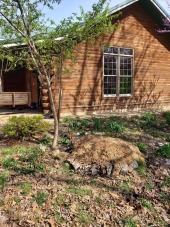
 1
1




![Filename: 20180214_203046.jpg
Description: Getting settled [Thumbnail for 20180214_203046.jpg]](/t/76565/a/58366/20180214_203046.jpg)
![Filename: 20180214_204607.jpg
Description: Starting to relax [Thumbnail for 20180214_204607.jpg]](/t/76565/a/58367/20180214_204607.jpg)
![Filename: 20180214_204629.jpg
Description: Chilling [Thumbnail for 20180214_204629.jpg]](/t/76565/a/58368/20180214_204629.jpg)
A human being should be able to change a diaper, plan an invasion, butcher a hog, conn a ship, design a building, write a sonnet, balance accounts, build a wall, set a bone, comfort the dying, take orders, give orders, cooperate, act alone, solve equations, analyze a new problem, pitch manure, program a computer, cook a tasty meal, fight efficiently, die gallantly. Specialization is for insects.
-Robert A. Heinlein
 1
1





When you reach your lowest point, you are open to the greatest change.
-Avatar Aang




A human being should be able to change a diaper, plan an invasion, butcher a hog, conn a ship, design a building, write a sonnet, balance accounts, build a wall, set a bone, comfort the dying, take orders, give orders, cooperate, act alone, solve equations, analyze a new problem, pitch manure, program a computer, cook a tasty meal, fight efficiently, die gallantly. Specialization is for insects.
-Robert A. Heinlein




"Study books and observe nature; if they do not agree, throw away the books." ~ William A. Albrecht












A human being should be able to change a diaper, plan an invasion, butcher a hog, conn a ship, design a building, write a sonnet, balance accounts, build a wall, set a bone, comfort the dying, take orders, give orders, cooperate, act alone, solve equations, analyze a new problem, pitch manure, program a computer, cook a tasty meal, fight efficiently, die gallantly. Specialization is for insects.
-Robert A. Heinlein




Chris Kott wrote:
So I have as yet to look into it, but the undyed, unbleached, recycled paper litter that we got her appears to contain a proprietary scent control product. I am doing a test in a compost pile that is somewhat dormant at present, to see if it has any negative effects on soil biology. My initial thought was that worms love paper, and that it would be beneficial to use unbleached, undyed, recycled paper waste in the garden for the worms.
-CK




 1
1
















Jen Rose wrote:
Good fodder crops include yellow dock, sunflowers, sunchokes, radishes and turnips (fast and easy to grow), and mustard. They,l eat just about every inch of every plant, including rootstock. dock root has been a bunny delicacy here, and it’s packed with minerals and nutrition! It can be dried and saved as well. The dock is chronically prolific and rabbits do good justice to thinning its ranks.
Spring seed pods on trees and fall leaf drop provide abundance.
Having a clean dry place to poop allows rabbits to do what their wild counterparts do; chew their pellets. They will eat s portion of their own poop for extra nutrition. Usually during the new moon phase. They store more pellets in a full moon when it’s bright and safe enough to forage at night. New moon is time to stay by the burrow and lay low in the poor visibility.




john mcginnis wrote:
Jen Rose wrote:
Good fodder crops include yellow dock, sunflowers, sunchokes, radishes and turnips (fast and easy to grow), and mustard. They,l eat just about every inch of every plant, including rootstock. dock root has been a bunny delicacy here, and it’s packed with minerals and nutrition! It can be dried and saved as well. The dock is chronically prolific and rabbits do good justice to thinning its ranks.
Spring seed pods on trees and fall leaf drop provide abundance.
Having a clean dry place to poop allows rabbits to do what their wild counterparts do; chew their pellets. They will eat s portion of their own poop for extra nutrition. Usually during the new moon phase. They store more pellets in a full moon when it’s bright and safe enough to forage at night. New moon is time to stay by the burrow and lay low in the poor visibility.
What is the trick? My rabbits won't touch sunchokes at all.
 I honestly don't know what to tell ya!
I honestly don't know what to tell ya!



A human being should be able to change a diaper, plan an invasion, butcher a hog, conn a ship, design a building, write a sonnet, balance accounts, build a wall, set a bone, comfort the dying, take orders, give orders, cooperate, act alone, solve equations, analyze a new problem, pitch manure, program a computer, cook a tasty meal, fight efficiently, die gallantly. Specialization is for insects.
-Robert A. Heinlein
 1
1




A human being should be able to change a diaper, plan an invasion, butcher a hog, conn a ship, design a building, write a sonnet, balance accounts, build a wall, set a bone, comfort the dying, take orders, give orders, cooperate, act alone, solve equations, analyze a new problem, pitch manure, program a computer, cook a tasty meal, fight efficiently, die gallantly. Specialization is for insects.
-Robert A. Heinlein

|
I remember before the flying monkeys became such an invasive species. We had tiny ads then.
A rocket mass heater is the most sustainable way to heat a conventional home
http://woodheat.net
|


